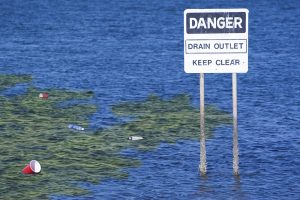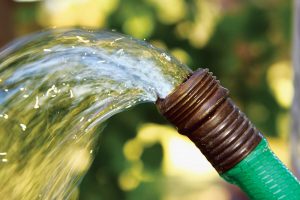Water has been under a lot of stress in modern times. Each year, the world generates roughly 36 trillion kilograms (400 billion tons) of waste, which, unfortunately, for many years ended up in the world’s rivers, streams, lakes, and oceans. According to the U.S. Geological Survey (USGS), 50 percent of groundwater supplies in North America are contaminated with pesticides. Water is subject to everything within the environment, including organic debris, petroleum, air pollution, and nutrients such as phosphates and nitrates. What does this have to do with swimming pools and hot tubs? Simple, water is the industry’s main ingredient, without good quality water being readily available the industry has nothing to offer.

Fortunately, a lot of work is being done around the globe to clean the world’s water supply and restore it to its original state. It is the industry’s main ingredient, without good quality water being readily available the industry has nothing to offer.
For centuries, these water bodies have been viewed as magical sources of dilution for the world’s waste. As a result, water pollution has reached unprecedented levels and sustainable, good water sources are shrinking. Further, drought and the increase in worldwide population are leading to water supply challenges that have already started to affect the pool and hot tub industry. One example of this occurred in Atlanta, in 2008, when the city was 90 days away from running out of useable water. This resulted in an emergency ban on water use, which prohibited the draining and filling of swimming pools. And, last year’s extreme drought in Texas resulted in water rates increasing by 300 percent in many areas.
Fortunately, a lot of work is being done around the globe to clean the world’s water supply and restore it to its original state. A big part of this effort is looking at ways to remove contaminants and solids from water. In the pool industry, however, this is quite the opposite as much of what is done for water treatment is based on adding more solids rather than removing them. This practice leads to more pool water saturation and build-up of solids, resulting in more frequent draining. To avoid this, the following are some methods for keeping pool and hot tub water closer to its original state, whereby preventing the contamination and build-up that leads to waste.
Dealing with and removing source contaminants

The very water that goes from the hose to the pool can itself be a challenge. Water can be soft with very little mineral content, causing it to be aggressive and corrosive to plaster and metals as it seeks saturation in its effort to become balanced.
The very water that goes from the hose to the pool can itself be a challenge. Water can be soft with very little mineral content, which causes it to be aggressive and corrosive to plaster and metals as it seeks saturation in its effort to become balanced.
Some areas, where deep groundwater is the main source, can be filled with minerals (mainly calcium). This is considered hard water, which can contribute to scale on pool surfaces, and in particular, heat exchangers. Calcium precipitates well in warmer water; therefore, source water must be properly evaluated and treated depending on the region and water type.
Other challenges with source water can be the presence of metals such as iron (Fe) and copper (Cu). These hidden metal ions can precipitate out from the pool water and cause problems such as water discolouration and pool surface stains. To combat this, maintaining proper water balance and the use of metal control chemicals is recommended.
Another problem is chlorimination from the municipality. This is a practice of combining chlorine (Cl) with ammonia (NH3) to create chloramines (NH2Cl), which have a weak but long lasting disinfection residual. This is done to ensure there is still disinfection residual when the water finally reaches the home. Many who fill pools with chloriminated source water find it difficult to create and maintain a proper free available chlorine (FAC) level. To avoid this, the use of a chlorine-free oxidizer is suggested to breakup any inorganic chloramines before adding chlorine to the pool. Typically, 0.45 kg (1 lbs) of a potassium monopersulfate (MPS) to 38,000 L (10,000 gal) of water will take care of this.
Further, the use of a good, natural-based clarifier helps pick up organic waste and take it to the filter. When organic by-products are removed to the filter, the water can be sanitized more efficiently, using fewer chemicals. Phosphates can also be a problem, particularly in agricultural areas, where they can be contained in groundwater. Also, many municipalities use an orthophosphate treatment to prevent corrosion in the underground pipes. Nitrates (NO−3) can also be difficult in certain areas as it can be contained in groundwater in addition to being airborne. Airborne nitrates are often found in areas where dairy cattle are present.

Phosphates can lead to algae resistant problems; therefore, phosphate removers should be used as they turn the by-product into a solid precipitate that can be removed from the water by the filter.
Phosphates can lead to algae resistant problems as well as reduce the ability of salt chlorine generators from producing FAC. To prevent this, phosphate removers should be used as they turn the by-product into a solid precipitate that can be removed from the water by the filter.
Nitrates, on the other hand, combine with chlorine to form chloramines, resulting in high chlorine demand. Unfortunately, at present time, there is no practical chemical means for nitrate removal from a swimming pool. The only way to remove this by-product is to drain and dilute the nitrates. Rather than draining a large volume of water from the pool all at once, it is better to drain smaller amounts more frequently and dilute the pool with fresh water to prevent the build-up of contaminants and get better results from using fewer chemicals.
Reducing hardness and solids when draining is restricted
What options are available if a swimming pool requires draining but this action is restricted? One option is the use of reverse osmosis (RO). This technology, which uses a pressurized membrane unit to separate molecules and ions from the solution, has been used in water treatment for many years. Also referred to as nano-filtration, RO is used to separate solids (e.g. salts) from water to reduce salinity and hardness with little impact on the pool’s water supply.
Old-school treatment creates unsustainable water
Many water treatment methods involve the introduction of large amounts of salt-based chemicals, which build-up as dissolved solids and lead to oversaturated water. This makes balancing the water more difficult and increases the amount of sanitizer needed to keep a residual.
The amount of chemicals required to keep pool water clean and sanitary can be reduced greatly by using a proper filtration system. Many pools are built with undersized circulation pumps and filter units, which lead to dead spots and poor water circulation and filtration. In these cases, chemicals are needed more frequently, and at higher doses, as the water is not being cleaned properly. This is another reason why natural-based clarifiers, which help to remove organic waste more quickly, are beneficial.

With better filtration systems and proper care and maintenance, swimming pools will remain clean and clear with minimal chemical use.
Many sanitizers contain by-products that get left behind in the pool water. Trichloroisocyanuric acid (C3Cl3N3O3) ‘tri-chlor’ is one example of chlorine that also contains cyanuric acid (CNOH)3. The by-product of using tri-chlor as a swimming pool sanitizer is the increase in cynauric acid levels, which adds to total dissolved solids (TDS) and leads to oversaturation of the water. The old-school method of treating every water quality problem with lots of chemicals needs to be re-evaluated. With better filtration systems and proper care and maintenance, swimming pools will remain clean and clear with minimal chemical use.
Keeping pool water cleaner, longer
The key to maintaining clean pool water is to keep it balanced and sanitized by using as little chemical as possible. Again, this is where proper equipment sizing and understanding the chemical by-products help. For example, many products used for metals contain phosphates as a by-product; therefore, when these products are used, phosphate levels and overall solids also increase. Using the appropriate chlorine sanitizer for the type of source water being used is also important.
If the water used to fill a swimming pool is taken from an area where high calcium hardness levels exist, it would not be wise to use calcium hypochlorite (cal-hypo) (Ca[ClO]2) as this will lead to an oversaturation of calcium and the need to drain water from the pool. Cal-hypo is better suited for areas with soft water, where natural calcium is lacking and is required to keep the water from being overly corrosive.
Use specialty chemicals judiciously. Look for products that remove as opposed to those that leave lots of by-product behind. Again, natural clarifiers work by gathering small micron-organic waste and removing it to the filter. Phosphate remover efficiently rids contaminants from the pool water by taking it to the filter where it is eventually backwashed out. Chemicals that remove more than they add are beneficial in keeping pool water sustainable for longer periods of time.
Become a water advocate
The pool industry will be under much more scrutiny as water continues to be an issue of supply and demand. This will come from government regulators, environmental organizations, and the general public.
Positive goodwill can be created based on how the industry views and treats swimming pool water day in and day out. This starts with basic water education. Partnering with local water officials and municipalities is also a positive way to stay informed and offer help in times of drought or emergency.
Further, volunteering to educate both the industry and consumers how pools and hot tubs can conserve water and be used in times of emergency is another positive. For example, pool water can be used to fight brush fires, and in extreme cases it can also be used for flushing toilets and watering.
It is important to always use water wisely and purposefully. Never leave water running when completing filter maintenance work or during swimming pool refills. Also, practice the routine of frequent, small draining and dilution to keep pool water fresh and avoid having to drain and refill the entire pool in one shot. This will help to maintain lower solid levels as well as lead to less chemical usage. Water is an important ingredient in everyday life, how it is treated will determine its future.
This article was written by Terry Arko and originally appeared on Pool & Spa Marketing [link].
